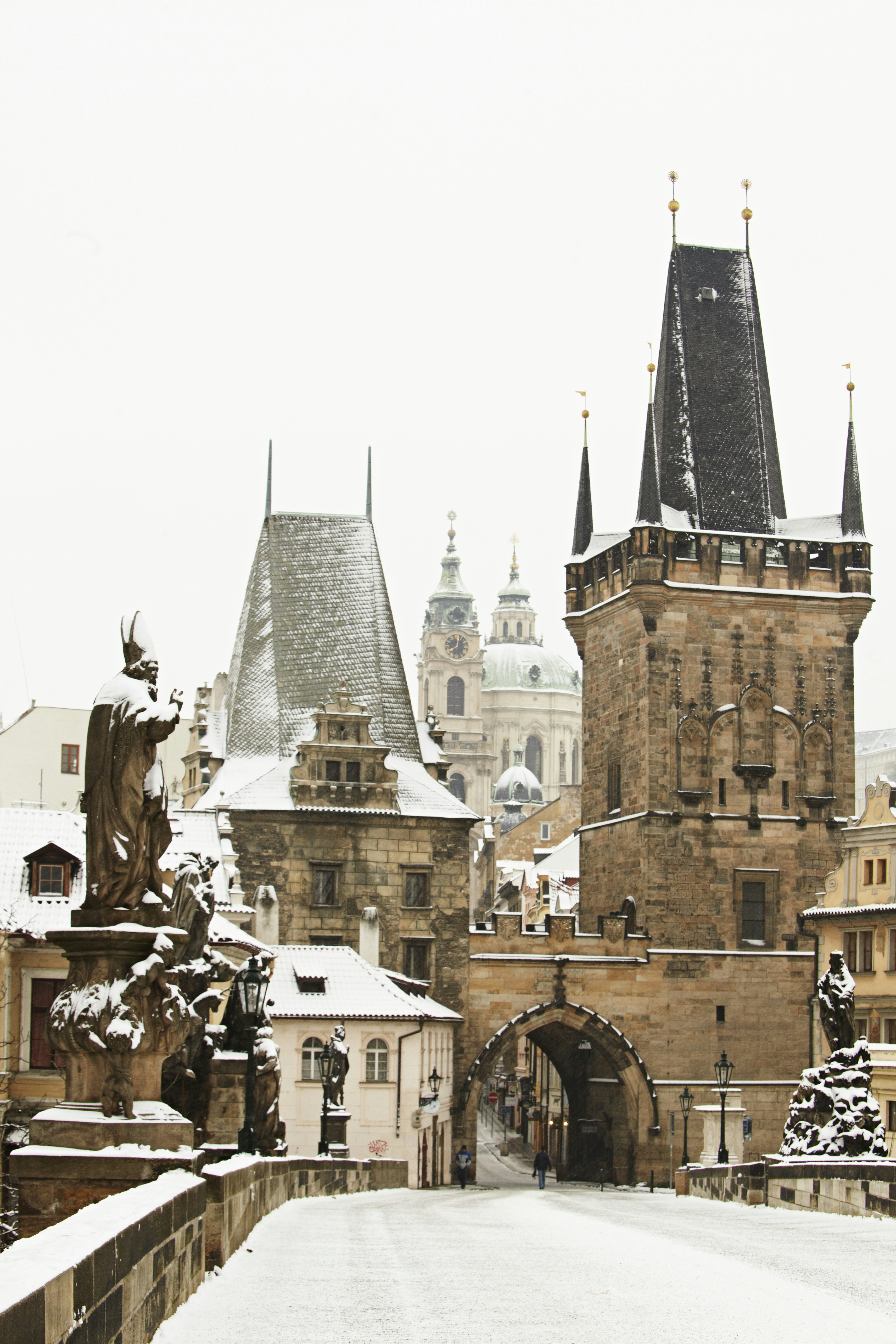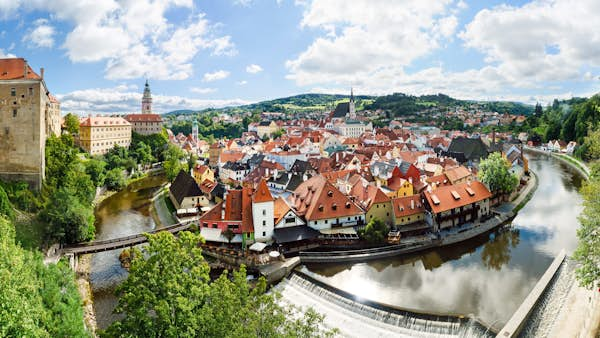Czechia’s capital, Prague, is one of Europe’s most-popular destinations. The city was spared significant war damage over the centuries and its trove of stunning historical architecture – Gothic, baroque and art nouveau – remains intact. Pair this with Prague’s picturesque setting astride the Vltava River and you’ve got the makings for one of the world’s most beautiful cities. Prague, of course, is more than architecture. It’s a vibrant European capital, with first-rate museums, concert houses, restaurants, clubs and – yes – pubs. Many come simply to sample some very highly regarded Czech beer.
Outside of Prague, Czechia is far less traveled by international visitors. The country’s western province of Bohemia offers stately castles, historic spa architecture at famous resorts like Karlovy Vary (Karlsbad), and beer-themed tourism to hopping cities like Plzeň (Pilsen) and České Budějovice (Budweis). The eastern province of Moravia – known better for its wine than beer – beckons with wine tastings in the shadow of UNESCO-protected chateaux and exciting city destinations, like Brno and Olomouc. This latter under-visited royal town recalls shades of Prague in its preserved baroque architecture and gracious public squares.
Advertisement
Plan your time and budget in this captivating Eastern European country with our guide for first-time visitors.

When should I go to Czechia?
Time your visit for spring (April to June) or autumn (September to October); both pack plenty of sunny days and warm (though not yet hot) daytime temperatures. Spring is especially beautiful as trees bud and flowers bloom in early April. Avoid high summer (July to August), when temps can climb into the upper 30°Cs (90°Fs) and tourist crowds swell on Prague’s Old Town Square. Over the winter months (November to March), the number of visitors thins, but the colder weather and reduced daylight hours make travel less enjoyable. Christmas and New Year are an exception – book flights and hotels over these holidays well in advance.
How much time should I spend in Czechia?
Budget at least two full days to take in the best of Prague. Plan an overnight for a trip to either Karlovy Vary or Český Krumlov (neither is close enough to Prague for a comfortable day trip). Tack on a couple more days if you’re planning on heading east to visit Moravia’s wine country or Olomouc. One week is enough to touch on Czechia’s highlights and get a feel for the place.

Is it easy to get to and around Czechia?
Prague’s Václav Havel Airport, located 15km (9 miles) from the center, is the country’s main international gateway; flights arrive here daily from around Europe. From the airport, trolleybus 59 or taxis bring you into the city in about 30 minutes. Prague is located on main European rail and bus lines, with daily international train service to Budapest, Vienna and Berlin, among others.
For travel within Czechia, trains and buses are reliable and reasonably priced. The transportation network is dense, with most destinations lying within a few hours of Prague. If you’re driving your own car, most long-distance stretches are connected by a four-lane highway, though roads get crowded over weekends and during the summer travel season. Parking in bigger cities, such as Prague and Brno, can be tricky. Arrange parking in advance through your hotel.
Top things to do in Czechia
Absorb Prague’s architectural splendor
Start a walk through the Czech capital’s medieval core at the Powder Gate, one of the original Gothic entryways into the Old Town. Proceed through lively Old Town Square, where a 15th-century Astronomical Clock chimes on the hour. Follow tiny lanes out onto Gothic Charles Bridge, memorably topped with baroque statues. Wind your way through more medieval lanes and make the trek up to Prague Castle, the seat of power for Bohemian rulers for more than 1000 years. There’s not another 3km (1.9-mile) stretch quite like it in all of Europe.
Advertisement
And that’s just the start. Explore Prague’s Jewish Museum to find the surviving remnants of Jewish life going back centuries. Walk through the baroque Vrtbov or Wallenstein Garden, or hike up to the Petřín and Letná gardens for truly breathtaking views of the Old Town below. In warm weather after sunset, head to the Vltava riverbank, Náplavka, to find a raucous party scene, or hit outlying neighborhoods – like Vinohrady, Karlín or Holešovice – to discover local life away from the throngs of visitors.

Take the waters in Karlovy Vary
Another trove of eye-catching architecture awaits in the Western Bohemian spa town of Karlovy Vary. In the 18th and 19th centuries, “Vary” (as Czechs call it) attracted kings, aristocrats, artists and composers from around Europe to decompress, stroll the historic colonnades and sip healing water from the medicinal springs. All of that finery is still here, but the good news is you no longer need to be wealthy to indulge. Buy your own spouted ceramic drinking cup to sample the springs then climb into the verdant hills around the town and admire the wedding-cake buildings from above.
Hike and sip wine in Mikulov
The southern Moravian town of Mikulov – besides being a highly picturesque place in its own right – offers the chance to combine hiking or cycling with tastings at numerous wineries, often in the owner’s private wine cellar. The Mikulov Wine Trail leads off from here for some 65km (40 miles) and passes important UNESCO heritage sites, such as the magnificent chateaux at Lednice and Valtice, on its way to some of the country’s most important wine-growing regions. Wine tastings are held within the Valtice chateau itself, while Mikulov’s main street, simply called Náměstí (Square), is filled with restaurants, wine shops and wine bars.

Gawk at Olomouc’s squares and churches
The former Habsburg fortress town of Olomouc is uncommonly majestic. Emperor Franz Joseph I was crowned here in 1848 and not much – at least in the center – has changed since then. The big baroque churches, like St Michael’s, are dazzling, but the biggest drawcard might be the spacious upper and lower town squares, the former dotted by a 35m-high (115ft) baroque Trinity Column, the largest single baroque sculpture in Central Europe and a UNESCO World Heritage Site. Part of the medieval town walls are still standing and rise above parkland that’s perfect for peaceful walks.
My favorite thing to do in Czechia: wander around Český Krumlov
Český Krumlov, in southern Bohemia, is the most beautiful place you’ve probably never heard of. I never get tired of ambling around the twisting, impossibly picturesque lanes and trying to catch the best view out over Krumlov’s soaring Renaissance tower and grandiose chateau – the old pile of the noble Rožmberk family for 300 years (till about 1600). I like to walk the streets and follow the Vltava River as it winds through the center and then reward myself with lunch at a cozy spot, like Švejk, or some grilled meats at Krčma Šatlava, a historic tavern.

How much money do I need for Czechia?
Prices have risen rapidly in recent years but remain lower than more expensive continental destinations like Germany, France or Italy. Take advantage of daily lunch specials at restaurants or multi-person “family” admissions at museums to cut costs. Credit and debit cards are widely accepted – and are becoming more the norm rather than cash. Note that Czechia uses the Czech crown (Kč), not the euro. Some sample local prices:
-
Double room at a top hotel in Prague: 6000Kč (US$270)
-
Double room at a budget hotel: 2500Kč (US$114)
-
Glass of (good) domestic wine at a bar or restaurant: from 160Kč (US$7.25)
-
Coffee at a trendy Prague cafe: from 80Kč (US$3.65)
-
Lunch in Prague (two courses without drinks): from 300Kč (US$13.60)
-
Dinner out (three courses without drinks): from 600Kč (US$27)
-
Museum entry (adult): 350Kč (US$15.90)
-
Taxi from Prague airport to the center: 600Kč (US$27)
What languages are spoken in Czechia?
English is widely spoken in Prague and other big cities and by anyone in contact – at hotels, restaurants and tourist offices – with international visitors. Czech, a Slavic language, is considered very difficult to learn. That said, memorizing a couple words goes a long way toward generating a few smiles. Dobrý den (doh’·bri den) – “good day” – is a standard greeting. Děkuji (dye’·ku·yi) means “thank you.”

Do I need to book hotels and restaurants far ahead of my travel dates?
For travel to Prague, reserve your hotel as far in advance as possible – especially if you’re planning on going over the peak summer season or during popular holidays, such as New Year’s or Easter. Rooms are not as tight outside of Prague, but advance bookings are a good idea over weekends or national holidays. Book popular restaurants a week in advance to secure a table. If you don’t have reservations, try showing up outside traditional mealtimes.
Is Czechia a safe destination?
Yes, the country is safe with a very low crime rate. That said, visitors should be wary of a few classic (relatively rare) tourist scams. When obtaining local currency, don’t go to private exchange booths that charge exorbitant conversion fees. Use bank ATMs instead. Never change money on the black market (always a scam). Unscrupulous taxi drivers occasionally overcharge for rides. Use popular ride-share apps, like Uber or Bolt, where the risk of being ripped off is minimal.

